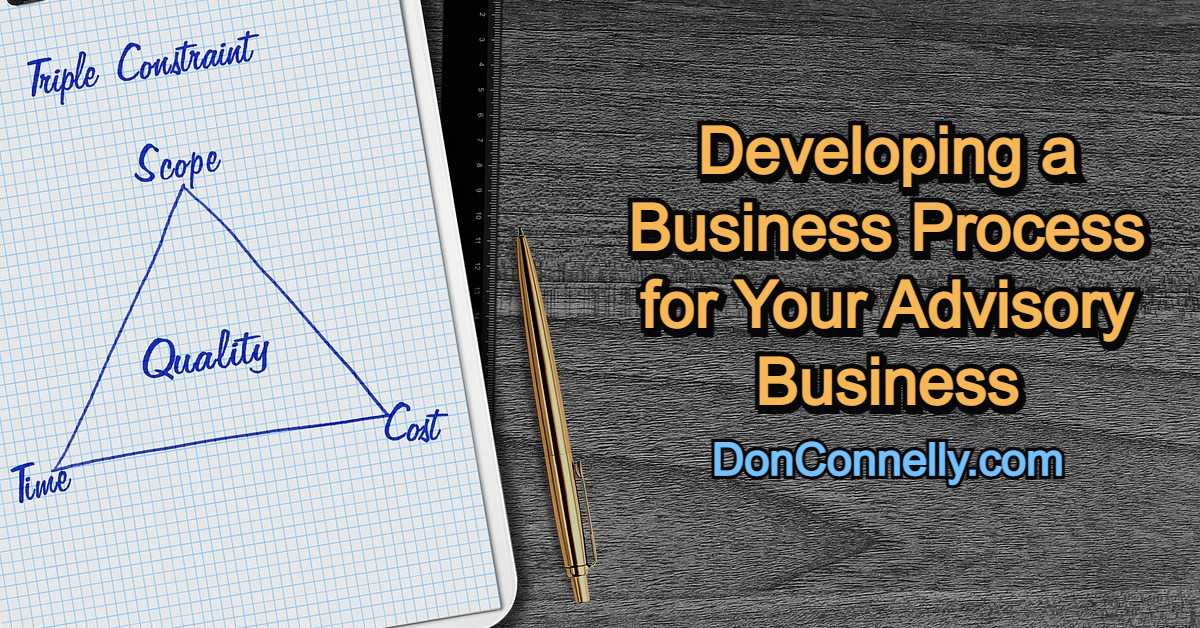Developing a Business Process for Your Advisory Business
 Advisors embarking on the challenge of growing an advisory business understand that the key to sustainable growth is to be able to specialize in their core business of business development and client management. However, with that growth comes increasingly complex operations in all facets of the business, which can consume resources and hinder growth.
Advisors embarking on the challenge of growing an advisory business understand that the key to sustainable growth is to be able to specialize in their core business of business development and client management. However, with that growth comes increasingly complex operations in all facets of the business, which can consume resources and hinder growth.
Smaller advisory businesses are disadvantaged by the lack of scale and resources, so they must rely on clearly defined, repeatable, and well-documented business processes to optimize their resources.
What are business processes?
A business process is comprised of a series of tasks organized into a workflow designed to achieve a specific objective. Tasks are broken down into actions or steps required to complete them, with roles, responsibilities, and timelines assigned to a team member. When documented and implemented, the business process becomes a repeatable and measurable framework for performing a function or operation.
Clearly defined business processes for critical functions enable an advisory business to do more with less through increased productivity and more effective task management, which is the equivalent of scaling the business.
With a business process, every team member is provided with specific responsibilities and clear directions, so no resource is wasted. When properly implemented, a well-designed process can:
- Increase productivityby streamlining functions and improving workflows.
- Enhance performanceby helping team members better understand how their roles contribute to the organization’s objectives. With the ability to monitor and measure their contributions, the organization can help team members enhance their performance.
- Control or reduce costsby maximizing available resources and finding more cost-effective ways to achieve organizational objectives.
- Create a better client experienceby enabling the team to execute processes that improve client satisfaction.
Developing a business process
There is a process for developing a business process comprised of seven repeatable steps that can be used to achieve multiple business objectives.
#1. Establish business objectives
The key to establishing business objectives is first to identify the overarching goal for the business. For example, if the goal is to become the leading boutique advisory firm in the area, it may require successfully achieving several business objectives. They might include increasing assets under management, attracting and hiring quality advisors, increasing the firm’s visibility and authority, increasing client engagement, and other key objectives critical to achieving the overall goal.
#2. Create an action plan for each objective
Each objective requires an action plan comprised of detailed tasks and steps to complete them. It then becomes easier to assign resources, roles, and responsibilities along with a timeline for implementing the action plan.
#3. Assign roles and responsibilities for tasks
Roles and responsibilities for completing tasks can then be assigned based on team members’ expertise and skills. With clear directions and timelines, team members can be held accountable for their specific role in completing the action plan.
#4. Execute the action plan
When executed, action plans become processes to be implemented by those assigned to manage the workflows. Following a training session to familiarize team members with the steps and resources to be applied, you can conduct a test run to gauge its effectiveness and make necessary adjustments.
#5. Install the process
As business processes are developed, they need to be integrated into the daily workflows of assigned team members. One team member should be given the role of overseeing the process and reporting on its operation at a weekly review session.
#6. Monitor and measure
Monitoring and measuring a business process is critical to ensure it’s achieving the expected outcome. Each process should be assigned vital metrics that can tell you how it’s impacting costs, efficiencies, and productivity. Regardless of the process being measured, it should have a quantifiable objective for comparing incremental progress toward the objective.
#7. Adjust as necessary
Once implemented, a business process should be evaluated regularly to make adjustments if needed. If a process is working as envisioned, you may want to determine how to make it work better. If it’s not working, you need to identify the reason and make changes. If the organization’s goals or priorities change, you may need to make changes to the business process to keep it aligned with the new direction. By evaluating processes regularly, you can make minor tweaks rather than more disruptive major changes that might be needed with infrequent assessments.
Then rinse and repeat for each new business process to develop and implement.
Watch this 2-minute video to learn how our learning center can help you ignite your performance and take your business to the next level.
See Membership Levels & Benefits
We recommend the PLATINUM membership level for its best value for money. Go PLATINUM now!



